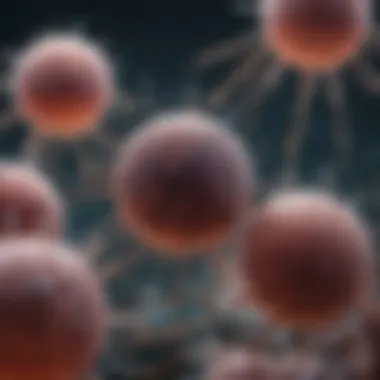Understanding Bacteriophages: Their Role and Impact


Intro
Bacteriophages, often referred to simply as phages, represent a unique and complex group of viruses. They predominantly target bacteria, thus playing an essential role in the microbial ecosystem. Recent concerns over increasing antibiotic resistance underscore the significance of these entities. A deeper understanding of bacteriophages can open new paths for innovative treatments and applications in public health. Initially discovered in the early 20th century, bacteriophages have been a focal point for researchers aiming to develop alternative therapies to combat bacterial infections. This article will explore various facets of bacteriophages, including their structure, function, and potential applications in modern science.
Recent Advances
Latest Discoveries
Recent discoveries in the field of bacteriophage research highlight their potential as therapeutic agents. Phage therapy, the application of bacteriophages to treat bacterial infections, is gaining momentum in laboratories and clinics worldwide. A notable mention is the use of bacteriophages to target multidrug-resistant strains of bacteria, offering a ray of hope in the fight against so-called superbugs.
Major studies have indicated that certain phages can effectively kill pathogens like Escherichia coli and Staphylococcus aureus. Researchers are conducting trials that take creative approaches to tailor phages for specific infections. For instance, by combining bacteriophages with antibiotics, scientists aim to enhance the effectiveness of existing treatments.
"Bacteriophages present a revolutionary alternative to antibiotics, potentially reshaping our approach to combating bacterial diseases."
Technological Innovations
Technological innovations have accelerated advancements in phage research. A significant development is the application of genomic sequencing, which allows scientists to decode the genetic material of various phages. This process aids in identifying specific phage-bacterial interactions and refining phage therapy applications.
Another innovative approach involves CRISPR technology, which enhances the ability to edit phage genomes. This provides opportunities for phages to be customized for improved efficiency in attacking specific bacteria. The potential combination of CRISPR and bacteriophage therapy builds a promising avenue for future research.
Methodology
Research Design
Studies on bacteriophages often utilize a mixed-method approach. Researchers adopt both qualitative and quantitative analyses to explore the efficacy of specific phages. Laboratory experiments typically involve controlled environments where bacteriophages are tested against various bacterial strains. Studies assess not only the capability of phages to eliminate bacteria but also their safety profiles in biological systems.
Data Collection Techniques
Data collection in phage research employs multiple methods. Common techniques include:
- Plaque assays: to measure the concentration of phages in a solution.
- Transmission electron microscopy: to visualize phage morphology and structure.
- Genetic sequencing: to analyze the genetic components and potential alterations in phages.
Phage-target interactions can be systematically investigated to provide a clearer understanding of how they function and their potential therapeutic roles.
In summary, the study of bacteriophages intricately intertwines microbial ecology, biological research, and practical applications in medicine. With ongoing advancements, a future where phages serve as key allies in health could become a reality.
Prelims to Bacteriophages
Bacteriophages, often simply referred to as phages, are a vital component in the complex interactions within microbial ecology. Understanding them is essential for several reasons. First, they offer a unique perspective on the dynamics between viruses and bacteria, which frame many aspects of life on Earth. Phages are not only fascinating from a biological standpoint but also hold significant practical implications in biotechnology and medicine, particularly with the rising concern of antibiotic resistance.
The exploration of bacteriophages entails a deep dive into their structures, lifecycle, and classifications, which all provide insight into how they influence bacterial populations. Gaining an understanding of phages can illuminate their ecological role, revealing the delicate balance they maintain in ecosystems.
Moreover, the research and applications of bacteriophages are rapidly evolving. Phage therapy, for instance, is emerging as a promising alternative to traditional antibiotic treatments, which is critical given the increasing incidence of antibiotic-resistant infections. This section serves as a portal into the world of bacteriophages, providing context for their historical significance, relevance in modern science, and future potential.
Definition of Bacteriophages
Bacteriophages are viruses that exclusively target bacteria. They consist of a protein coat that encases their genetic material, which can be either DNA or RNA. The versatility of phages in their host specificity makes them particularly intriguing. Each type of bacteriophage has a unique structure and method of infection, typically involving the attachment to a specific bacterial cell surface and then injecting their nucleic acid into it.
Understanding what bacteriophages are fundamentally involves dissecting their two major components: the capsid, which protects the viral genome, and the tail fibers, which facilitate the recognition and binding to the host bacterium. This specificity not only underscores their potential in medical applications but also highlights their role in regulating bacterial populations in natural environments.
Historical Discovery
The history of bacteriophages dates back to the early 20th century, first being described independently by Frederick Twort and Félix d'Hérelle. In 1915, Twort discovered a virus that could destroy bacteria, although he couldn't characterize it fully. A few years later, in 1917, d'Hérelle provided a more comprehensive analysis, showing how these entities could be used to combat bacterial infections. His work paved the way for phage research and therapy, marking the beginning of an exciting field in microbiology.
Since those early days, advancements in our understanding of bacteriophages have transformed our view of them from mere curiosities to powerful tools in treating infections. This journey underscores the remarkable potential of phages and the need for continued research into their diverse applications across various fields.
Biology of Bacteriophages


The biology of bacteriophages is essential to understand their role in the environment and potential applications in biotechnology and medicine. By examining the structure and life cycle of these viruses, researchers can uncover how they interact with bacterial hosts and influence microbial communities. This information is valuable for developing phage therapies, enhancing molecular biology tools, and exploring ecological functions.
Structure and Composition
Protein Coat (Capsid)
The protein coat, or capsid, of bacteriophages serves a crucial function in protecting their genetic material. This coat is typically composed of protein subunits, known as capsomers. The arrangement of these capsomers forms a protective shell, which is critical for the stability of the phage in various environments. A key characteristic of the capsid is its ability to withstand harsh conditions, allowing the phage to survive outside its host for extended periods. This durability is a beneficial feature, as it enables effective transmission to new bacterial cells. Additionally, the uniform structure of the capsid facilitates the efficient packaging of the nucleic acid, whether it is DNA or RNA.
Nucleic Acid (DNA/RNA)
Nucleic acid, which can be either DNA or RNA, serves as the foundation of any bacteriophage. This genetic material contains all the instructions necessary for phage replication and function. A notable characteristic of nucleic acids in bacteriophages is their diversity in structure and replication strategies. Depending on the phage type, the nucleic acid can be double-stranded DNA, single-stranded DNA, double-stranded RNA, or single-stranded RNA. This diversity in genetic material contributes to the adaptability of bacteriophages in different environments and increases their potential applications in research and medicine. The uniqueness of the nucleic acid sequence defines the specific host range and the interactions with the bacterial cell's machinery.
Tail Fiber Proteins
Tail fiber proteins are essential for the attachment of bacteriophages to their bacterial hosts. These structures are usually long, flexible appendages that can recognize and bind to specific receptors on the surface of bacteria. The distinct characteristic of tail fibers stems from their role in determining host specificity. Each bacteriophage has tail fibers designed to latch onto certain bacteria, which makes them highly targeted agents for bacterial infections. This specificity can be advantageous for therapeutic applications, as it reduces collateral damage to beneficial bacteria. However, the challenge lies in the variability of receptors on bacterial surfaces, which may lead to potential host specificity issues in therapeutic settings.
Replication Cycle
Attachment and Penetration
The first step in the bacteriophage life cycle is attachment and penetration. During this phase, the phage uses its tail fibers to latch onto a specific receptor on the host bacterium's surface. This precise attachment is critical for subsequent steps in the replication cycle. Once attached, the phage injects its nucleic acid into the bacterial cell. This step is significant because it ensures that the phage's genetic material directly enters the host's machinery. The efficiency of this process is a benefit for phage therapy, as it can lead to a rapid takeover of the bacterial cell, making the virulent strains easy to target.
Synthesis of Phage Components
After successful penetration, the bacteriophage hijacks the host's cellular machinery to synthesize its components. This synthesis involves replicating the phage's nucleic acid and producing the proteins needed to form new phage particles. A key characteristic of this synthesis stage is its reliance on the host's replicative mechanisms, which can be both advantageous and disadvantageous. While this approach allows the phage to effectively produce new particles, it also means that variations in host cell activity could affect phage replication efficiency.
Assembly and Release
The final stage of the bacteriophage life cycle involves assembly and release. Newly synthesized phage components are assembled into complete viral particles within the host cell. Once assembly is complete, the host bacterium undergoes lysis, or cell rupture, releasing hundreds of new bacteriophages into the surrounding environment. This vast release is beneficial for the phage, as it increases its chances of infecting additional bacterial cells. However, this rapid cycle of infection and release can also lead to co-evolution between phages and bacteria, shaping microbial communities in significant ways.
Classification of Bacteriophages
The classification of bacteriophages plays a crucial role in understanding their diverse functionalities and applications. It helps scientists group these viruses based on their structural characteristics and genetic make-up. This differentiation not only aids in identifying specific bacteriophage types necessary for targeted therapies but also enhances the study of their ecological roles. By categorizing bacteriophages, researchers can better explore their potential in combating antibiotic-resistant bacteria, providing a pathway towards more effective solutions in medical contexts.
Categorization by Morphology
Icosaheral
Icosaheral bacteriophages are characterized by their distinct icosahedral shape. This morphology is significant as it provides robust protection for the viral genetic material. The structure consists of 20 equilateral triangular faces, which is optimal for stability. This makes icosaheral phages popular in studies related to phage therapy due to their efficiency in infecting bacterial cells.
The capsid's symmetrical nature is a benefit as it allows for easier manipulation in laboratory settings for research and therapeutic application. However, their specific structure might limit their effectiveness against a wider range of bacterial hosts, which is a consideration in developing broader treatments.
Filamentous
Filamentous bacteriophages exhibit a long, thin morphology. These phages are particularly fascinating due to their ability to infect bacteria through a unique mechanism that exploits the host's surface structures. The key characteristic of filamentous phages is their flexibility, which allows them to adapt to different bacterial sizes.
This adaptability is beneficial as it opens more pathways for infection, thus expanding their potential applications in biotechnological fields. On the downside, their elongated shape means they may experience structural vulnerabilities, which could affect their stability under different conditions.
Tailed
The tailed bacteriophages are among the most studied due to their complex structure, featuring a icosahedral head and a tail used for attaching to bacterial cells. This is significant as the tail facilitates the delivery of viral genetic material into the host. The key characteristic of tailed phages is their variation in tail length and structure, providing versatility in penetrating various bacterial species.
Their adaptability makes them strong candidates for future phage therapy developments. However, the reliance on specific receptor interactions could limit their effectiveness against different bacterial strains, presenting a challenge for their application in universal treatments.
Genetic Classification
Diverse Genomic Content


Diverse genomic content in bacteriophages refers to the varying genetic makeup that different phage types possess. This diversity is pivotal because it impacts how phages interact with their bacterial hosts and respond to environmental factors. The key characteristic of this variation is the presence of different genes that encode proteins necessary for infection and replication.
Understanding this genomic diversity is beneficial as it allows researchers to develop specific bacteriophage applications tailored to distinct bacterial infections. However, the complexity of genomic variations can make it challenging to predict phage behavior and efficacy in therapeutic settings.
DNA vs. RNA Phages
The distinction between DNA and RNA phages is a vital aspect of bacteriophage classification. DNA phages typically exhibit greater genetic stability, leading to more consistent behaviors over time, while RNA phages tend to evolve rapidly, which can be advantageous in specific environments. The key characteristic of RNA phages is their potential to adapt quickly to changing bacterial defenses, which can provide a significant advantage in dynamic ecological systems.
This distinction is important as it affects the approach to utilizing bacteriophages in therapies and diagnostics. While DNA phages may offer stability, RNA phages present opportunities for innovative strategies against rapidly evolving bacterial pathogens. However, this rapid evolution could also complicate their use in long-term treatment plans.
Ecological Role of Bacteriophages
Bacteriophages play a significant role in the ecology of microbial communities. They influence population dynamics, drive evolutionary changes, and maintain the balance within ecosystems. Understanding how these viruses interact with bacteria is vital for grasping their ecological significance.
Impact on Microbial Communities
Bacteriophages contribute to shaping microbial communities by regulating bacterial populations. Their predatory nature keeps the numbers of specific bacteria in check, preventing any single species from dominating an ecosystem. This activity promotes biodiversity and helps maintain the stability of microbial ecosystems. The presence of phages can induce shifts in bacterial communities, fostering a more balanced ecosystem especially in environments such as soil and aquatic systems.
Research has shown that bacteriophages can enable nutrient cycling by lysing bacterial cells. When phages infect and destroy bacteria, they release organic matter, which can then be utilized by other microbes. This action enhances nutrient availability and supports the growth of various organisms within the community.
Bacteriophages are a natural form of biological control, influencing microbial populations and enhancing ecological balance.
Additionally, host specificity is an important characteristic of bacteriophages. Many phages target specific bacterial strains, which can lead to selective pressures on those bacteria. This process can provoke genetic diversity in bacterial populations as they adapt to phage predation. Over time, such interactions can lead to co-evolution, where bacteria develop resistance strategies, and in turn, phages evolve new mechanisms to overcome these defenses.
Lysogenic vs. Lytic Cycles
The ecological impact of bacteriophages is intricately linked to their replication strategies, notably the lysogenic and lytic cycles. In the lytic cycle, phages enter bacterial cells, replicate rapidly, and cause cell lysis, releasing new phage particles. This results in a quick decline of the bacterial population.
Conversely, during the lysogenic cycle, a phage integrates its genetic material into the host bacterium's genome. This integrated phage DNA, known as a prophage, can remain dormant for extended periods. As the bacterial cell divides, it passes along the prophage. Under certain stress conditions, the prophage may activate, leading to the lytic cycle. This strategy provides a survival advantage to both the phage and the host, as it allows the bacterium to survive while controlling phage replication.
In summary, understanding the ecological role of bacteriophages sheds light on their influence over microbial communities and their implications for biotechnology and medicine. Their ability to regulate bacterial populations, promote biodiversity, and engage in complex life cycles showcases the importance of continuing to study these unique viruses.
Bacteriophages and Biotechnology
Bacteriophages, commonly called phages, are drawing significant attention in the field of biotechnology. Their unique ability to infect bacteria makes them powerful tools in various applications. The rise of antibiotic resistance has created a pressing need for alternative treatments. Phages present a viable option that could help overcome this challenge.
Phage Therapy: An Alternative to Antibiotics
Phage therapy leverages the natural predatory behavior of bacteriophages to target and kill specific bacterial pathogens. Unlike traditional antibiotics that can disrupt entire microbial populations, phage therapy is highly specific. This specificity reduces collateral damage to beneficial microbes in the gut or on the skin.
Research in this area has shown encouraging results. Phage therapy has been employed in treating infections caused by multidrug-resistant bacteria such as Pseudomonas aeruginosa and Staphylococcus aureus. Clinical trials indicate that phage therapy can effectively clear infections that do not respond to standard antibiotic treatments. However, practical application faces hurdles, including the selection of the right phage and its delivery to the infection site.
"Bacteriophages can change the landscape of infectious disease treatment by providing targeted bacterial eradication without the broad impacts of antibiotics."
Molecular Biology Applications
Beyond therapy, bacteriophages have numerous applications in molecular biology. Their role extends to gene cloning, where phages can be utilized as vectors to carry genetic material into bacterial cells. This method has profound implications for genetic engineering and synthetic biology.
Bacteriophages also contribute to the development of various diagnostic tools. Phage display technology enables researchers to present peptides on the surface of a phage, facilitating the identification of interactions between proteins and potential drug candidates. Such technologies enhance our understanding of protein functions and interactions, thereby advancing drug discovery.
In agricultural biotechnology, bacteriophages are being explored as biocontrol agents. They can selectively target pathogens that harm crops, reducing the need for chemical pesticides. This presents a sustainable alternative to traditional farming practices.
In summary, the biotechnological implications of bacteriophages are vast and still unfolding. As research continues, novel applications will likely emerge, further solidifying the importance of these viral entities in combating bacterial diseases and advancing biotechnological innovations.
Medical Applications of Bacteriophages
Bacteriophages have emerged as a promising tool in the medical field, particularly due to the increasing prevalence of antibiotic resistance. The importance of understanding their medical applications cannot be overstated. Rising bacterial resistance to antibiotics poses a significant threat, making phage therapy a necessary subject of study.


Phage therapy utilizes bacteriophages to target and kill specific bacteria, offering a tailored approach to treat infections. This specificity can reduce the risk of disrupting healthy microbiota, a common issue with broad-spectrum antibiotics. Researchers are exploring various aspects of phage therapy, including its effectiveness, safety, and integration with existing medical protocols. As this field develops, new methods for utilizing bacteriophages in medical applications are being identified, promoting the need for further investigation.
Current Research and Clinical Trials
Extensive research is underway to assess the efficacy of bacteriophages in treating bacterial infections. Clinical trials are an essential component of this research, providing insights into the practical application of phage therapy. Ongoing studies are testing phage therapy against various conditions, including chronic infections and surgical wound complications.
One significant trial involves using phages to treat antibiotic-resistant infections in patients with cystic fibrosis. Preliminary results have shown promising improvements in patient outcomes, suggesting a new avenue for treatment where conventional antibiotics fail. Additionally, the safety profile of all the administered phages must be monitored, ensuring that they do not cause adverse effects or provoke immune responses.
The research landscape is characterized by collaboration among various institutions, often leading to multi-center trials that enhance the validity of the results. The findings from these studies will not only inform future clinical practices but also regulatory policies surrounding phage therapy.
Phage-Based Diagnostics
In addition to therapeutic applications, bacteriophages also play a significant role in diagnostics. Phage-based diagnostic methods are developing as a novel approach to identify bacterial pathogens accurately. This rapid identification is crucial in clinical settings, where timely intervention can drastically alter patient outcomes.
Phages can be engineered to bind specifically to target bacteria, enabling their use in test kits. These kits can identify infections quickly, potentially reducing the time and resources spent on traditional culture methods.
Several studies have shown that these diagnostics can be as accurate as conventional techniques, but with the added benefits of speed and specificity. This could change the landscape of microbiological diagnostics, making it easier for clinicians to make informed treatment decisions.
The integration of bacteriophages in both therapeutic and diagnostic capacities demonstrates their versatile potential in medicine. Understanding their applications not only aids in addressing current health challenges but may also pave the way for innovative solutions in future healthcare.
Challenges and Limitations of Bacteriophage Utilization
Bacteriophages present many benefits, especially in the context of combating antibiotic resistance. However, their application has significant challenges that warrant discussion. Understanding these limitations is essential for researchers, healthcare professionals, and policymakers as they explore bacteriophage therapy.
Host Specificity Issues
A prominent issue facing bacteriophage utilization is host specificity. Bacteriophages are often narrow-spectrum. This means they target specific bacterial strains while leaving others unaffected. Such specificity poses a major challenge in clinical settings. For instance, the desired phage may only infect a few strains of a pathogenic bacterium. This can limit the effectiveness of phage therapy in patients infected with multiple bacterial strains or those with antibiotic-resistant infections.
Also, the genetic diversity of bacteria means that the same strain can vary significantly from one individual to another. Therefore, a phage that works in one patient may not be effective for another. This variance in bacterial populations complicates treatment protocols. As a result, tailored phage therapy could require thorough screening, which is often a time-consuming process.
The narrow host range of phages leads to potential complications in therapeutic applications and necessitates careful consideration in treatment planning.
Regulatory Concerns
Regulatory challenges further complicate the utilization of bacteriophages. Current regulations for phage therapy are not well-defined in many regions. The lack of clear guidelines contributes to uncertainty among clinicians regarding treatment protocols and patient safety. In contrast, conventional antibiotics have a well-established regulatory framework, making their use straightforward.
The approval process for bacteriophage therapy could be long and complicated. This might deter practitioners from considering phage therapy as a viable option. Moreover, there is ongoing debate about whether bacteriophages should be classified as drugs or biologics. Each classification comes with its own set of regulatory requirements.
The need for extensive clinical trials adds another layer of complexity. Demonstrating efficacy and safety in diverse populations is paramount. However, conducting such studies may require significant resources and time. Consequently, the slow pace of regulatory approval can hinder the introduction of promising therapies into clinical practice.
Future Perspectives on Bacteriophage Research
The future of bacteriophage research is promising and has gained momentum in various scientific fields. As antibiotic resistance becomes a pressing global issue, phages present a compelling alternative for treating bacterial infections. This section elaborates on emerging technologies in bacteriophage studies and the potential for combination therapies that can enhance therapeutic efficacy.
Emerging Technologies
In recent years, advancements in technology have significantly influenced the research landscape of bacteriophages. Key developments include genomic sequencing, bioinformatics, and CRISPR technology. These tools allow researchers to better understand phage biology and interaction with bacterial hosts. For instance, whole-genome sequencing enables the identification of specific genetic traits that could enhance phage efficacy in targeting bacteria.
Another important innovation is the use of high-throughput screening techniques. Such methods accelerate the process of isolating and characterizing new bacteriophages. Notably, techniques like next-generation sequencing facilitate rapid identification of phage genomes, aiding in creating phage libraries tailored to combat specific bacterial pathogens.
Additionally, synthetic biology has opened new avenues for engineering phages for enhanced performance. Through targeted genetic modifications, scientists can design phages with improved ability to evade bacterial defenses, increase infection rates, or enhance stability in various environments. This research focuses heavily on ensuring the safety and effectiveness of bacteriophages as therapeutic agents.
"Emerging technologies are paving the way for a new era in bacteriophage research, highlighting their potential to combat pathogens effectively and safely."
By integrating these technologies into phage research, scientists can develop more sophisticated and nuanced bacteriophage therapies, making it feasible to use these agents broadly in clinical settings.
Potential for Combination Therapies
Combination therapies incorporating bacteriophages with traditional antibiotics or other antimicrobial agents are an area of active investigation. This approach could prove useful in overcoming issues related to antibiotic resistance. By using bacteriophages alongside antibiotics, it may be possible to enhance the therapeutic outcomes. This synergistic effect is based on the premise that phages can help reduce the bacterial load, allowing antibiotics to work more effectively.
Studies have already shown that using phages can increase antibiotic susceptibility in resistant bacterial strains. For example, when phages target specific bacterial populations, it can momentarily weaken the bacteria, making them more vulnerable to antibiotic treatment. The complementary roles of phages and antibiotics can potentially lead to more effective treatment protocols for infections that are currently difficult to manage.
Moreover, combination therapies could also minimize the potential for the development of resistant bacterial strains. By applying two mechanisms of action, researchers hope to outpace the bacteria's ability to adapt. This approach necessitates thorough investigation and optimization to ensure that the combination is safe and efficacious.
In summary, the future perspectives on bacteriophage research highlight the critical intersections between innovative technologies and therapeutic strategies. As researchers continue to dissect the complexities surrounding bacteriophages, their relevance in addressing bacterial challenges will likely expand. The potential for creating a safe, effective, and robust therapeutic landscape is within reach.















